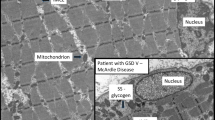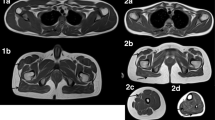Abstract
Muscle phosphoglycerate mutase (PGAM) deficiency has been so far identified in only six patients, five of these being African Americans. We report the results of clinical, morphological, biochemical, muscle culture and31P-MR spectroscopy studies in the first Caucasian patient with muscle PGAM deficiency. A 23-year-old man had a 10-year history of cramps after physical exertion with one episode of pigmenturia. Neurological examination and EMG study were normal. ECG and echocardiography revealed hypertrophy of the interventricular septum and slight dilatation of the left chambers of the heart. Muscle biopsy revealed increased glycogen content and some accumulation of mitochondria. Muscle PGAM activity was markedly decreased (6.5% and 9.7% of control value in two different biopsies). Citrate synthase and other mitochondrial respiratory chain enzyme activities were much higher than normal. In contrast to the marked decrease of PGAM activity observed in muscle biopsy, total enzyme activity in the patient's aneural muscle culture was normal, being represented exclusively by BB isoenzyme. The deficiency of PGAM-MM isoenzyme was reproduced in the patient's innervated muscle culture. Muscle31P-MR spectroscopy showed accumulation of phosphomonoesters only on fast “glycolytic” exercise. On “aerobic” exercise, Vmax, calculated from the work-energy cost transfer function, showed an increase consistent with the morphological and biochemical evidence of mitochondrial proliferation. This might represent a sort of compensatory aerobic effort in an attempt to restore muscle power.
Similar content being viewed by others
References
Argov Z, Bank WJ, Boden B, Ro Y, Chance B (1987) Phosphorus magnetic resonance spectroscopy of partially blocked muscle glycolysis: an in vivo study of phosphoglycerate mutase deficiency. Arch Neurol 44:614–617
Argov Z, Bank WJ, Maris J, Leigh JS Jr, Chance B (1987) Muscle energy metabolism in human phosphofructokinase deficiency as recorded by31P-nuclear magnetic resonance spectroscopy. Ann Neurol 22:46–51
Barbiroli B, Montagna P, Cortelli P, Funicello R, Iotti S, Monari L, Pierangeli G, Zaniol P, Lugaresi E (1992) Abnormal brain and muscle energy metabolism shown by31P magnetic resonance spectroscopy in patients affected by migraine with aura. Neurology 42:1209–1214
Bertocci LA, Hakker RG, Lewis SF, Fleckenstein JL, Nunally RL (1991) Abnormal high-energy phosphate metabolism in human muscle phosphofructokinase deficiency. J Appl Physiol 70:1201–1207
Bresolin N, Ro Y, Reyes M, Miranda AF, Di Mauro S (1983) Muscle phosphoglycerate mutase (PGAM) deficiency: a second case. Neurology 33:1049–1053
Bresolin N, Bet L, Moggio M, Meola G, Fortunato F, Comi G, Adobbati L, Geremia L, Pittalis S, Scarlato G (1989) Muscle glucose-6-phosphate dehydrogenase deficiency. J Neurol 236:193–198
Castella-Escola J, Ojcius DM, LeBoulch P, Joulin V, Blouquit Y, Garel MC, Valentin C, Rosa R, Climent-Romeo F, Cohen-Solal M (1990) Isolation and characterization of the gene encoding the muscle-specific isozyme of human phosphoglycerate mutase. Gene 91:225–232
Chance B, Eleff S, Bank W, Leigh JS Jr, Warnell R (1982) 31P-NMR studies of control of mitochondrial function in phosphofructokinase-deficient human skeletal muscle. Proc Natl Acad Sci USA 79:7714–7718
Chance B, Leigh JS Jr, Clark BJ, Maris J, Kent J, Nioka S, Smith D (1985) Control of oxidative phosphorylation and oxygen delivery in human skeletal muscle: a steady-state analysis of the work-energy cost transfer function. Proc Natl Acad Sci USA 83:8384–8388
Chance B, Leigh JS Jr, Kent J, McCully KK, Nioka S, Clark BJ, Maris JM, Graham T (1986) Multiple controls of oxidative metabolism in living tissues as studied by phosphorus magnetic resonance. Proc Natl Acad Sci USA 83:9458–9462
Di Mauro S, Miranda AF, Khan S, Gitlin K, Friedman R (1981) Human muscle phosphoglycerate mutase deficiency: newly discovered metabolic myopathy. Science 212:1277–1279
Di Mauro S, Miranda AF, Olarte M, Friedman R, Hays AP (1982) Muscle phosphoglycerate mutase deficiency. Neurology 32:584–591
Di Mauro S, Dalakas M, Miranda AF (1983) Phosphoglycerate kinase deficiency: another cause of recurrent myoglobinuria. Ann Neurol 13:11–19
Duboc D, Jehenson P, Tran Din S, Marsac C, Syrota A, Fardeau M (1987) Phosphorus NMR spectroscopy study of muscular enzyme deficiencies involving glycogenolysis and glycolysis. Neurology 37:663–671
Kanno T, Sudo K, Takeuchi I, Kanda S, Honda N, Nishimura Y, Oyama K (1980) Hereditary deficiency of lactate dehydrogenase M-subunit. Clin Chim Acta 108:267–276
Kissel JT, Beam W, Bresolin N, Gibbons G, Di Mauro S, Mendell JR (1985) Physiologic assessment of phosphoglycerate mutase deficiency: incremental exercise tests. Neurology 35:828–833
Martinuzzi A, Askanas V, Kobayashi T, Engel WK, Gorsky JE (1987) Developmental expression of the muscle-specific isozyme of phosphoglycerate mutase in human muscle cultured in monolayer and innervated by fetal rat spinal cord. Exp Neurol 96:365–375
Meola G, Scarpini E, Velicogna M, Mottura A, Baron PL, Beretta S, Scarlato G (1986) Analysis of fibronectin expression during human muscle differentiation. Basic Appl Histochem 30:153–163
Meola G, Bresolin N, Rimoldi M, Velicogna M, Fortunato F, Scarlato G (1987) Recessive CPT deficiency: biochemical studies in tissue cultures and platelets. J Neurol 235:74–79
Meola G, Velicogna M, Sertorelli S, Santilli I, Scarlato G (1989) Early and persistent successful functional innervation in human muscle cocultured with fetal mouse spinal cord complex. Eur J Neurosci [Suppl 2]:229
Miranda AF, Peterson ER, Masurovsky EB (1988) Differential expression of creatine kinase and phosphoglycerate mutase isozymes during development in aneural and innervated human-muscle culture. Tissue Cell 20:179–191
Petroff OAC, Prichard JW, Behar KL, Alger JR, Shulman T (1984) Cerebral metabolism in hyper- and hypo-carbia:31P and1H nuclear magnetic resonance studies. Magn Reson Med 1:589–593
Tsujino S, Shanske S, Sakoda S, Fenichel G, Di Mauro S (1993) The molecular genetic basis of muscle phosphoglycerate mutase (PGAM) deficiency. Am J Hum Genet 52:472–477
Vita G, Toscano A, Bresolin N, Meola G, Barbiroli B, Baradello A, Messina C (1990) Muscle phosphoglycerate mutase (PGAM) deficiency in the 1st caucasian patient. Neurology 40[Suppl 1]:296
Zaniol P, Serafini P, Ferraresi M, Golinelli R, Bassoli P, Canossi I, Aprilesi GC, Barbiroli B (1992) Muscle 31P-MR spectroscopy performed routinely in a clinical environment by a whole-body imager/spectrometer. Phys Med 8:87–91
Author information
Authors and Affiliations
Rights and permissions
About this article
Cite this article
Vita, G., Toscano, A., Bresolin, N. et al. Muscle phosphoglycerate mutase (PGAM) deficiency in the first Caucasian patient: biochemistry, muscle culture and31P-MR spectroscopy. J Neurol 241, 289–294 (1994). https://doi.org/10.1007/BF00868435
Received:
Revised:
Accepted:
Issue Date:
DOI: https://doi.org/10.1007/BF00868435




